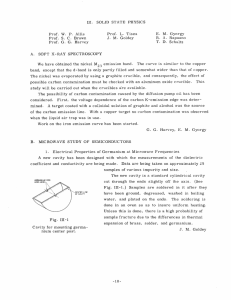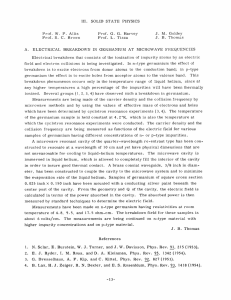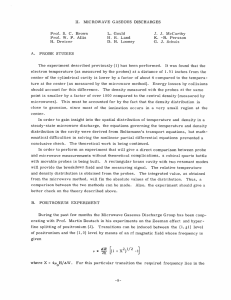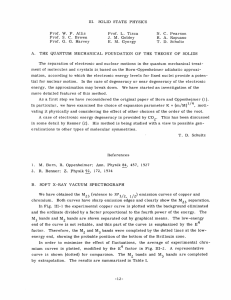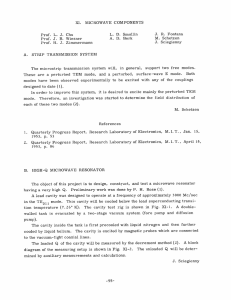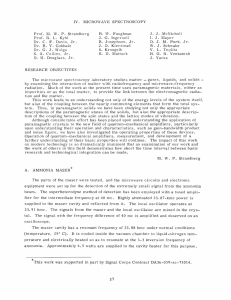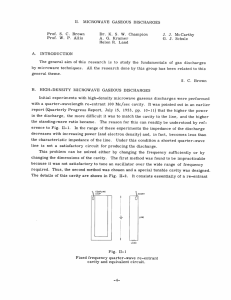Prof. W. P. Allis
advertisement
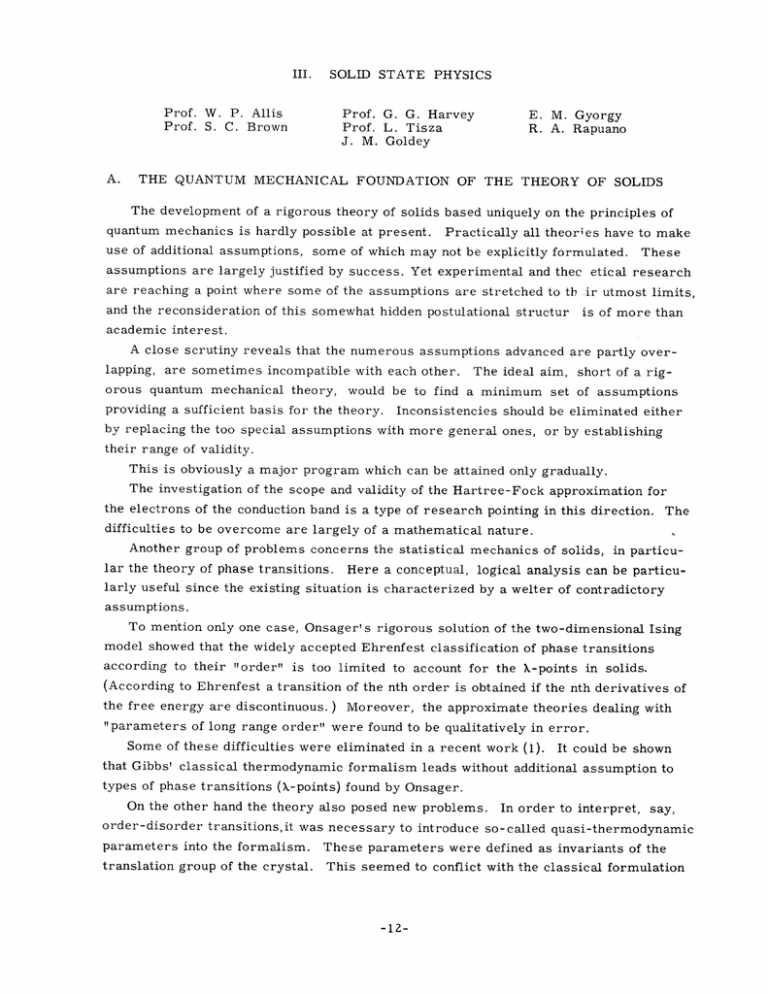
III. Prof. W. P. Allis Prof. S. C. Brown A. SOLID STATE PHYSICS Prof. G. G. Harvey Prof. L. Tisza J. M. Goldey E. M. Gyorgy R. A. Rapuano THE QUANTUM MECHANICAL FOUNDATION OF THE THEORY OF SOLIDS The development of a rigorous theory of solids based uniquely on the principles of quantum mechanics is hardly possible at present. Practically all theories have to make use of additional assumptions, some of which may not be explicitly formulated. These assumptions are largely justified by success. Yet experimental and thec etical research are reaching a point where some of the assumptions are stretched to th ir utmost limits, and the reconsideration of this somewhat hidden postulational structur is of more than academic interest. A close scrutiny reveals that the numerous assumptions advanced are partly overlapping, are sometimes incompatible with each other. The ideal aim, short of a rigorous quantum mechanical theory, would be to find a minimum set of assumptions providing a sufficient basis for the theory. Inconsistencies should be eliminated either by replacing the too special assumptions with more general ones, or by establishing their range of validity. This is obviously a major program which can be attained only gradually. The investigation of the scope and validity of the Hartree-Fock approximation for the electrons of the conduction band is a type of research pointing in this direction. The difficulties to be overcome are largely of a mathematical nature. Another group of problems concerns the statistical mechanics of solids, in particular the theory of phase transitions. Here a conceptual, logical analysis can be particularly useful since the existing situation is characterized by a welter of contradictory assumptions. To mention only one case, Onsager' s rigorous solution of the two-dimensional Ising model showed that the widely accepted Ehrenfest classification of phase transitions according to their "order" is too limited to account for the X-points in solids. (According to Ehrenfest a transition of the nth order is obtained if the nth derivatives of the free energy are discontinuous. ) Moreover, the approximate theories dealing with "parameters of long range order" were found to be qualitatively in error. Some of these difficulties were eliminated in a recent work (1). It could be shown that Gibbs' classical thermodynamic formalism leads without additional assumption to types of phase transitions (-points) found by Onsager. On the other hand the theory also posed new problems. In order to interpret, say, order-disorder transitions,it was necessary to introduce so-called quasi-thermodynamic parameters into the formalism. These parameters were defined as invariants of the translation group of the crystal. This seemed to conflict with the classical formulation -12- (III. SOLID STATE PHYSICS) of the ergodic theorem which very strictly limits the parameters which survive the statistical averaging process and which are admissible in a macroscopic theory. In other words, conventional statistical mechanics has been developed with the view of being applied to fluids and has no provision for the adequate handling of crystalline symmetry. The problem is to develop a theory in which statistical procedures and symmetry considerations are unified into a coherent scheme. It can be shown that this can be carried out only within quantum mechanics. Such a unified theory has actually been developed, at least in outline and a detailed report is being prepared. Reference 1. B. R. Smoluchowski, J. E. Mayer, W. A. Weyl: On the General Theory of Phase See especially the chapter "Phase TransTransition, John Wiley, New York, 1951. formations in Solids, " by L. Tisza, also published as Technical Report No. 127, Research Laboratory of Electronics, M.I.T. 1949. SOFT X-RAY VACUUM SPECTROGRAPH While we have substantially reduced the contamination of the target surface by magnetic deflection of the electron beam, it has not yet been possible to obtain a satisfactory emission curve of chromium, and this study has been discontinued until we obtain a better sample of the metal. We decided to attempt the study of iron next, since iron does not contaminate as rapidly as chromium. The evaporation technique is satisfactory, and preliminary investigation of the iron emission curve has shown some promise. A new, all-tantalum electron gun is being constructed to replace the present one most of the parts of which are of nickel. It is hoped that this will enable us to reduce materially contamination from the gun. G. G. Harvey, E. C. M. Gyorgy MICROWAVE STUDY OF SEMICONDUCTORS 1. Electrical Properties of Germanium at Microwave Frequencies Experiments are being undertaken to study the properties of germanium by the microwave method. The current work consists of measuring the dielectric constant A thin germanium rod is placed coaxially in a resonant cavity and standing wave measurements are made on the line as a function of frequency. A block diagram of the circuit is shown in Fig. III-1. The klystron generates 10-cm waves and and conductivity. -13- (III. SOLID STATE PHYSICS) the resonant cavity oscillates in the TM 0 10 mode. A theory for the microwave fields in such a cavity is being developed (1). Pre- liminary results using the equations of Bethe and Schwinger (2) and Birnbaum (3) have been obtained for a small rectangular SONANT ;AVITY filament of p-type material. SECTION The sample was assumed to be cylindrical with a diameter of 0. 0254 inch and was placed in a Fig. III-1 cavity of 2. 875 inches diameter. Block diagram of apparatus. The equations used in the calculations were S 1) (E'- X 1 -X o EZdV sample 2 f EZdV cavity E2dV E" 1 Q1 1 sample o SE 2dV cavity where X and XI are the resonant wavelengths for the empty and loaded cavity, respectively; and Qo and Q1 represent the unloaded Q's of the cavity empty and with the sample inserted. E' is the real part of the specific dielectric constant and E" is the imaginary part. These equations were developed for a low loss (E"/E' << 1) substance and there- fore only qualitative significance may be attached to the results obtained. Eight sets of data were taken; the sample was removed and remounted after the first four. The results are consistent and reproducible. E' D(percent) E" D(percent) tan 6 D(percent) Ist four 15.4 1.3 41.2 0. 73 2. 69 1.1 2nd four 15.4 1.3 41.7 0.48 2. 71 1.1 total 15.4 1.3 41.4 0.48 2. 70 0. 7 Experiments are being performed to determine the effect of the size of the sample used on the measured properties. J. M. Goldey -14- (III. SOLID STATE PHYSICS) References 1. H. H. T. Hsieh: Quarterly Progress Report, Solid State and Molecular Theory Group, M.I.T. Jan. 15, 1952 2. H. Bethe, J. 3. G. Birnbaum: Schwinger: J. NDRC DI-117, App. Phys. 20, 1943 817, 1949 -15-
